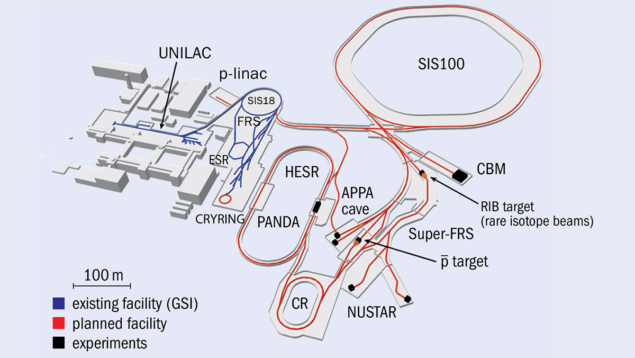 The Facility for Antiproton and Ion Research (FAIR) in Darmstadt, Germany, is embarking on a pioneering mission that will transform accelerator research and expand our understanding of the universe. With its ambitious vision to explore an extensive research canvas, FAIR is set to become a global hub for scientific exploration, spanning diverse domains such as hadron physics, nuclear structure, astrophysics, atomic physics, materials science, radiation biophysics, cancer therapy and space science.
The Facility for Antiproton and Ion Research (FAIR) in Darmstadt, Germany, is embarking on a pioneering mission that will transform accelerator research and expand our understanding of the universe. With its ambitious vision to explore an extensive research canvas, FAIR is set to become a global hub for scientific exploration, spanning diverse domains such as hadron physics, nuclear structure, astrophysics, atomic physics, materials science, radiation biophysics, cancer therapy and space science.
At its core, FAIR will generate primary beams of various particles, ranging from protons to uranium ions, along with secondary beams of antiprotons and rare isotopes. This state-of-the-art accelerator facility will deliver intense and energetic particle beams to multiple production targets, guiding these beams to fixed-target experiments or injecting them into specialized storage rings for in-ring experiments with high-quality secondary antiprotons or radioactive ions.
The driving force behind FAIR’s cutting-edge research capabilities lies in its three main building blocks: the fast-ramping SIS100 synchrotron, responsible for generating intense primary beams; the Super Fragment Separator (Super-FRS), designed to filter out exotic ion beams; and the storage rings. Additionally, the existing GSI accelerators, UNILAC and SIS18, will serve as injectors and pre-accelerators for SIS100, while a new proton linac will facilitate high intensity injection into the synchrotron chain.
At the forefront of FAIR’s scientific mission is the crucial role played by cryogenics, with Holger Kollmus and Marion Kauschke, head and deputy head of the GSI/FAIR cryogenics program, leading the way. Cryogenics has emerged as an indispensable aspect of FAIR's operations. As Kollmus explains, “The strategic decision to build FAIR placed ultralow-temperature technology at the heart of GSI’s development roadmap. The Prototype Test Facility (PTF) was established to evaluate candidate magnet designs, while the Series Test Facility (STF) enhanced workflow efficiency for large-scale testing of the SIS100 dipole magnets.” Commenting on the significance of the STF, Kauschke adds, “Custom building design and layout were pivotal in realizing workflow efficiencies at the STF. Through streamlined testing processes, we optimized throughput and successfully tested all SIS100 dipoles.”
 The cryogenics program at GSI/FAIR is a collaborative endeavor, fostering partnerships with other cryogenics groups across Europe. Collaboration with CERN, renowned for its superconducting magnets in high energy physics, has been instrumental in accelerating cryogenics advancements. Notably, superconducting magnets for the Super-FRS underwent acceptance testing at CERN before being integrated into FAIR’s facilities.
The cryogenics program at GSI/FAIR is a collaborative endeavor, fostering partnerships with other cryogenics groups across Europe. Collaboration with CERN, renowned for its superconducting magnets in high energy physics, has been instrumental in accelerating cryogenics advancements. Notably, superconducting magnets for the Super-FRS underwent acceptance testing at CERN before being integrated into FAIR’s facilities.
The journey towards realizing FAIR’s cryogenic infrastructure has been marked by meticulous planning and innovation. The cryogenic supply building features two independent halls with distinct foundations. The front hall, housing cold boxes and distribution lines, connects to the SIS100 tunnel without disrupting helium transfer. The rear section, housing the compressor station, is decoupled from the cold box hall to minimize vibrations on the SIS100 ring.
CRYO2, FAIR’s central cryogenic plant, lies at the heart of this infrastructure, providing cryogenic capacity at ultralow temperatures. With variable-frequency drivers for compressors, the plant ensures adaptability to load changes, enabling parallel and independent operation for FAIR’s diverse cryogenic consumers. The cold helium is distributed across the campus through an extensive network.
As FAIR’s cryogenic infrastructure nears completion, the potential for groundbreaking discoveries is vast, and cryogenics at FAIR has opened up exciting avenues for unparalleled research. The eagerly anticipated inauguration of FAIR in 2027 holds the promise of unveiling scientific marvels that will significantly contribute to our understanding of the universe. FAIR’s cryogenic journey highlights the profound impact of scientific discovery on society and the world at large, with the ability to explore the uncharted territories of the cosmos an extraordinary opportunity.
Image 1: From here to FAIR: The existing GSI accelerators (blue) and the FAIR facilities (red). FAIR comprises the SIS100 synchrotron; the antiproton separator and the Super Fragment Separator; the collector ring; high energy storage ring; and experimental stations for the APPA, CBM, NUSTAR and PANDA research programs. The proton linac and the CRYRING (a low-energy storage ring for heavy ions) also belong to the FAIR instrumentation portfolio. Credit: CERN
Image 2: Test and measurement: The STF (left) handled the volume testing of FAIR’s SIS100 dipole magnets (110 in total). Meanwhile, CERN’s specialist test facility (right) is overseeing acceptance of Super-FRS superconducting magnets prior to delivery to Darmstadt. Credit: Gabi Otto/GSI; Stephan Russenschuck/CERN



